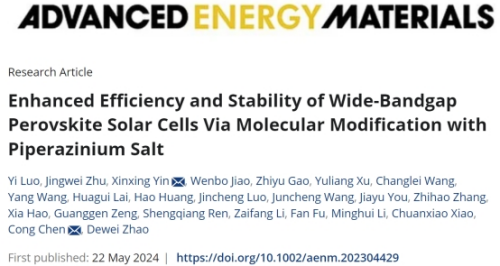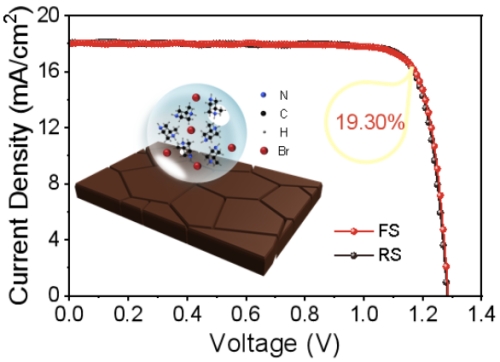
On May 22nd, Cong Chen, an associate research fellow at the College of Materials Science and Engineering, reported on the latest research results of wide-bandgap perovskite solar cells, and published the findings in an article "Enhanced Efficiency and Stability of Wide Bandgap Perovskite Solar Cells Via Molecular Modification with Piperazinium Salt" in Advanced Energy Materials. Sichuan University is the first work unit of this paper. The two corresponding authors are Cong Chen, and Dr. Xinxing Yin of Jiaxing University. Yi Luo, a Class 2023 doctoral student from the School of Materials Science and Engineering, is the first author.
"Wide-bandgap (WBG) perovskite solar cell (PSC) plays a pivotal role as the top subcell in all-perovskite tandem solar cells (TSCs), facilitating the absorption of high-energy photons and affording a large open-circuit voltage (VOC). Nonetheless, the stability and efficiency of WBG PSCs are constrained by light- radiative induced halide segregation and non- recombination losses. In this study, this work presents an approach of utilizing 2-methylpiperazinium bromide (2-MePBr) via interfacial engineering to realize high-efficiency WBG (1.77 eV) PSCs. The C─NH─C functional group in 2-MePBr, serving as an electron donor, can interact with under-coordinated lead defects at the perovskite surface. Consequently, the treatment with 2-MePBr mitigates interfacial non-radiative recombination, enhances charge transport, inhibits ion migration, and thus delivers an improved power conversion efficiency (PCE) of 19.30% with a VOC of 1.29 V, and a fill factor of 83.08%. Notably, the WBG PSCs manifest enhanced stability, preserving 80% of the initial PCE after 337 h of continuous operation under 1 sun illumination at the maximum power point. Furthermore, the all-perovskite TSCs based on this WBG subcell achieve a PCE of 27.47%, showing its promising application in perovskite-based tandem solar cells." (Abstract)

There search was funded by the National Natural Science Foundation of China, Fundamental Research Funds for the Central Universities, Engineering Featured Team Fund of Sichuan University, Creative Project of Engineering Research Center of Alternative Energy Materials & Devices, Ministry of Education, Sichuan University, and Key Technologies Research and Development Program.
https://onlinelibrary.wiley.com/doi/10.1002/aenm.202304429
